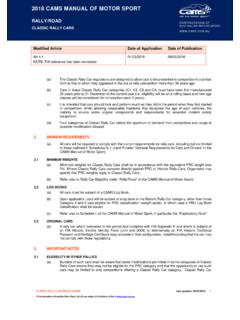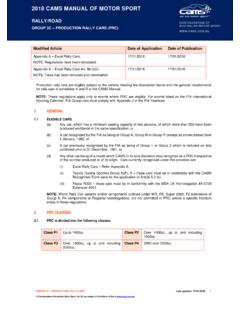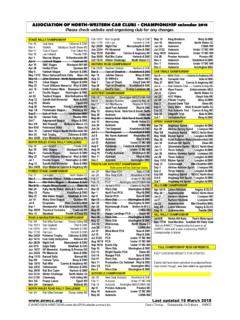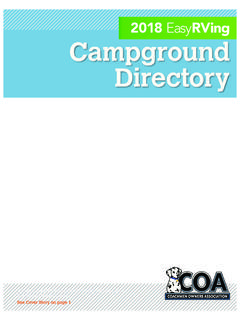Transcription of 2018 CAMS MANUAL OF MOTOR SPORT
1 2018 cams MANUAL OF MOTOR SPORT . rally / ROAD CONFEDERATION OF. AUSTRALIAN MOTOR SPORT . RALLYSPRINT STANDING REGULATIONS. WWW . Modified Article Date of Application Date of Publication 1. RALLSPRINT. (a) A Rallysprint is a non-special stage rally in accordance with NRC (b) A Rallysprint may be held on closed or private roads of sealed and/or unsealed surface/s. (c) The course may consist of up to two separate sections, each being no longer than 8km. Each section may be traversed in both directions, making a maximum of four stages. Each stage may be attempted a maximum of three times ( , three runs on each stage). Where the risk profile of the event does not change an organiser may make application to cams to vary the number runs and length of sections providing the total distance does not exceed 96kms. (d) Competitors must start each section from a standing start under the vehicle's own motive force, and must complete the section in a reasonable time, as determined by the Clerk of the Course, their nominee or as specified in the Supplementary Regulations without assistance from other vehicles.
2 (e) Any road which is normally open to the public and which is defined as a "highway" or "public road" by a government authority, must be legally and physically closed to the public for the duration of the event. (f) These regulations must be read in conjunction with the National rally Code. Where an inconsistency exists these regulations shall apply only to the extent of the inconsistency. TYPES OF RALLYSPRINT. A Rallysprint shall be categorised as one of two types: (a) STAGE 1 (S1) RALLYSPRINT: A S1 Rallysprint is an introductory motorsport competition. Crew and vehicle eligibility are intended to be flexible with the objective to provide an avenue for new competitors and those from other introductory motorsport disciplines, Autotest and Speed Event, to participate in a rally -structured competition. Crew and Vehicle eligibility for S1 events are described in Article 6 and Article 8 of these regulations. A S1 Rallysprint may be conducted on sealed, unsealed or mixed surface.
3 Where an event is run on a mixed surface, the Supplementary regulations shall state whether the event is a sealed or unsealed surface event depending upon which surface type is predominant by over 50% of the course. A S1 Rallysprint must be conducted at a venue that is subject to a Rallysprint Venue Licence (refer Article 2). Such a venue shall represent a reduced risk environment to competitors. The relevant State rally Panel shall be responsible for assessing and approving the risk status of the venue. Crew and vehicle eligibility requirements aim to provide an avenue for S1 Rallysprint competitors to take steps towards experiencing Gravel Rallying or Tarmac Rallying. (b) STAGE 2 (S2) RALLYSPRINT: A S2 Rallysprint is a more advanced level of event, and may also be conducted on sealed, unsealed or mixed surfaces. The Supplementary regulations shall state whether the event is a sealed or unsealed surface event depending upon which surface type is predominant by over 50% of the course.
4 RALLYSPRINT STANDING REGULATIONS Last updated: 15/12/2017 1. Confederation of Australian MOTOR SPORT Ltd. All use subject to Conditions of Use at A S2 Rallysprint may be conducted at a venue approved in the same manner as a special stage rally conducted in that state, inclusive of approval by the appointed checker and relevant authorities. (c) NRC does not apply to a Rallysprint. 2. RALLYSPRINT VENUE LICENCE: (a) A S1 Rallysprint may only be conducted on a venue subject to a Rallysprint Venue Licence. The licence will normally only be issued for a venue which is either a dedicated MOTOR SPORT venue or one with a known history of events. (b) To have a venue recognised as such, an application shall be made to the relevant State rally Panel. (c) The application shall be accompanied by a detailed targeted risk assessment and the report of an experienced Checker. Where a venue is already the subject of a cams Category A, B or C Track Licence and the event will be running in accordance with the conditions of the Track Licence issued, save for the allowance of co-drivers in the vehicle, a new targeted risk assessment will not be required.
5 (d) The application shall include: a plan of the track/course to be approved (competition may only be conducted on the approved course), including details of any primary protection which may be in place at the venue ( barriers in front of trees etc);. an assessment by a Checker that concludes that the average speed will likely be below 90km/h at a sealed surface venue and for all cams Category C or higher venues issued with a Track Licence, or otherwise 70km/h at other venues;. details of the event Safety/Medical Plan;. whether or not the venue is subject of a Track Licence issued by cams or a 'civil' authority;. details of any known accidents/incidents over at least the past 12 months and details of any injuries and interventions required; and description of the surface - tarmac or unsealed sections of road may be used. (e) Once approved, the venue shall be subject of the Rallysprint Venue Licence and a Rallysprint event may be conducted at the venue thereafter in accordance with the conditions of the Rallysprint Venue Licence and these Rallysprint Standing Regulations.
6 3. CONTROL PROCEDURES, MARSHALLING AND TIMING. (a) The Clerk of the Course shall determine the method used for marshalling of cars to the start of each stage. For example, this may be done by using a time card and elapsed time for a stage (A-A timing), or a paddock marshalling process, or any other method advised to competitors that the Clerk of the Course deems effective. (b) The crew and their vehicle shall present at the start of a stage in accordance with the procedure described in 3(a) above. If a crew does not present ready to start as required by the procedure in 3(a). the Clerk of the Course (or other official delegated this responsibility) may disallow the crew to compete on that run, or may determine an alternate appropriate starting time, or/and may also impose a penalty in accordance with section of the National rally Code. Officials should take into account any known difference in the speed between competing crews when considering allowing a crew to start out of a pre-determined order.
7 The Clerk of the Corse (or other official delegated this responsibility) may authorise a longer period for the starting gap between each vehicle on safety or administrative grounds if required. NRC does not apply to a Rallysprint. (c) The Supplementary Regulations for the event must specify the timing system and timing interval to be used, as well as the method of recording the times. (d) A minimum starting gap between each crew of 30 seconds for sealed surfaces and 1 minute for unsealed surfaces must be maintained at all times. The starting gap to be used for the commencement of the event must be advised in the Supplementary Regulations for the event. RALLYSPRINT STANDING REGULATIONS Last updated: 15/12/2017 2. Confederation of Australian MOTOR SPORT Ltd. All use subject to Conditions of Use at (e) A Rallysprint may be timed to a maximum interval of one second. Timing to a shorter interval ( 1/10 or 1/100 of one second) is encouraged where possible.
8 It is strongly recommended that a fully automatic timing system be used. (f) The timing system should ideally provide for redundancy to prevent the possibility of mis-timing which may result in a competitor receiving a re-run. (g) There are no fixed penalties for late arrival at a start time control. NRC section does not apply. (h) Official times may be recorded automatically and/or remotely, for example, by a timing system device such as RallySafe, or Dorian, by an official writing on a physical record in the possession of the crew on a Road card, or by an official writing on a scoring sheet at the stop control or both. For a S2. Rallysprint where road cards are in use, a Position-on-Road indication must be used to track vehicles in the stage. For a S1 Rallysprint, Position-on-Road indication is encouraged where practical. (i) Elapsed time for each crew may be derived by deducting the start time from the finish time, or may be timed with stop-watches or other methods.
9 (j) Re-runs. A competitor may request a re-run for reasons of force majeure. Such request may only be approved by the Clerk of the Course. 4. DETERMINATION OF RESULTS. The winner of each competition within the event shall be the competitor who achieves the lowest aggregate elapsed time. The aggregate elapsed time shall be calculated by adding together the results for each crew from each run of each stage of the event (inclusive of penalties), with the exception of each crews worst result on each stage. A "worst result" may include where a competitor elects not to, or fails to, complete a run of the stage. At the discretion of the Clerk of the Course on each stage where 2 or less timed runs are completed, the "worst result" may not be discounted. Where a stage is competed more than 3 times, more than 1 'worst result' may be dropped. The number of 'Runs to Count' must be clearly defined in the Supplementary Regulations. 5. COMPETITORS' BRIEFING. (a) For the purpose of briefing each competitor a meeting of all competitors shall be called by the organisers prior to the commencement of practice/competition to reinforce safety procedures, regulations, allotted starting times etc.
10 (b) For S1 Rallysprints the crew briefing must include an explanation of the signs to be used, time control procedures, stopping in stage and emergency procedures. 6. CREW ELIGIBILITY. (a) For a S1 Rallysprint, each crew member must hold a minimum of a cams Level 2S licence. For a S2. Rallysprint, each crew member must hold a minimum of a cams Clubman rally or National rally Junior licence. (b) The minimum age for drivers and co-drivers in a Rallysprint is 14 years. (c) A competitor may only enter once, in each event, as a driver, with the following exception: A Competitor may enter and drive multiple vehicles if permitted in the event Supplementary Regulations. The same vehicle cannot be driven multiple times by the same driver. The vehicles cannot be from the same class as described in the event Supplementary Regulations. If the event is a part of a Series or Championship the driver will accrue points in each class, however they will only receive outright points based on the results obtained by one vehicle.
















